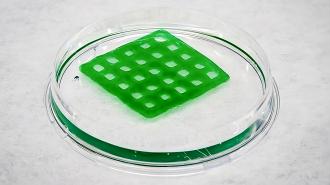A 3D-printed “living material” packed with genetically engineered bacteria could be an inexpensive, eco-friendly way to clean up polluted water, according to a new proof-of-concept study.
Polluted water: A large assessment of American rivers and lakes by the Environmental Integrity Project found that more than 50% are too contaminated with chemicals, pathogens, or other pollutants to even swim in.
While it is definitely possible to clean up this pollution, water treatments are typically expensive and energy intensive.
The idea: A naturally occurring protein — found in some plants, insects, and bacteria — called “laccase” reacts with certain common water pollutants in a way that degrades them or makes them less toxic.
The protein could be a cheaper, more sustainable alternative to traditional water decontamination methods, but no one has figured out a way to take what we’ve learned about laccase in the lab and safely apply it to the real world.
The “living material” neutralized the dye after 10 days.
What’s new? Now, researchers at the University of California San Diego (UCSD) have developed a “living material” they think could be the key to using laccase to clean up polluted water.
The material itself consists of a seaweed-based gel packed with cyanobacteria genetically engineered to continually produce laccase. To increase its surface area and efficacy, the researchers 3D-printed the material into a waffle-like shape — this also ensured that most of the microbes in it would have easy access to light, nutrients, and gasses, which helps them survive.
As a proof-of-concept, a bit of the living material was placed in water that had been contaminated with indigo carmine, a toxic dye regularly used by the textile industry. Ten days later, the dye was neutralized.

Kill switch: The bacteria were also genetically engineered so that a molecule found in black tea, called “theophylline,” would trigger them to produce a protein that causes their cells to break down.
“The living material can act on the pollutant of interest, then a small molecule can be added afterwards to kill the bacteria,” said co-lead researcher Jon Pokorski. “This way, we can alleviate any concerns about having genetically modified bacteria lingering in the environment.”
Looking ahead: So far, though, this is just a proof of concept, and dropping this material into a big lake or river is very different from a small test tube with only one pollutant. More research is needed into whether there are any risks to the treatment, how the tech could be scaled up, and what that might cost before we start hurling bacteria-laden waffles into polluted water in the real world.
As part of their future research, the UCSD team plans to look for a way to get the engineered bacteria to die off after a cleanup without the addition of a chemical, like theophylline, which isn’t native to waterways.
“Our goal is to make materials that respond to stimuli that are already present in the environment,” said Pokorski.
Even if they succeed, laccase can’t neutralize everything polluting our waterways, so we’ll need to continue exploring other solutions, while also taking action to prevent toxic substances from reaching our waters in the first place.
We’d love to hear from you! If you have a comment about this article or if you have a tip for a future Freethink story, please email us at [email protected].






